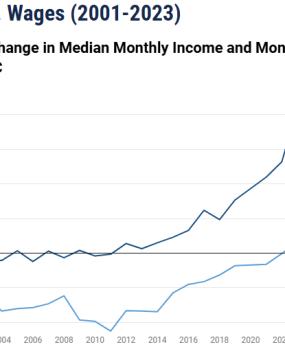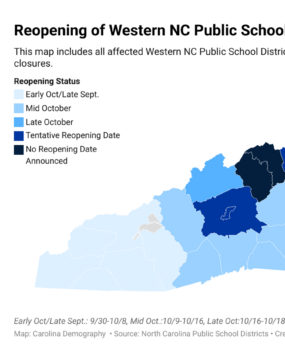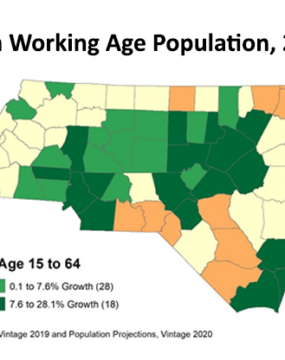Economic Data
Keep up with our latest demographic insights

This blog post expands on a previous blog post that examined housing cost burden across NC by focusing on the disparities between housing cost burden for homeowners and renters. In North Carolina, 66.8% of occupied housing units are owner-occupied, while 33.2% are renter occupied. According to Harvard’s Joint Center for Housing Studies’ 2025 report, nationwide, rental demands have been steadily increasing in recent years. Rental demand is especially pronounced among people aged 35-44 (prime first-time…

In recent years, housing has become a hot-button issue both nationwide and in our state, as many people struggle to find secure, affordable housing options. David Rouse, Ben Hitchings, and Anita Brown-Graham of the UNC School of Government’s ncIMPACT Initiative wrote that the three main factors contributing to the national housing crisis are affordability, availability, and accessibility. In this post, we examine state and NC county trends in the first of these factors: housing affordability.…

After this piece was published, our partners at myFutureNC pointed out that impacted school districts in the Northwest part of our state were excluded from the original analysis (Ashe, Burke, Caldwell, and others). This post has now been revised to include all school districts impacted by Helene in Western North Carolina. Three years after the pandemic, students in Western North Carolina (WNC) are confronting a new challenge: the aftermath of Hurricane Helene. The storm, which…

The labor force participation rate describes the percentage of people 16 or older who are working or actively looking for work. Nationally, the seasonally-adjusted labor force participation rate for the United States in June 2021 was 61.6%. In North Carolina, the participation rate was 59.2%, 2.4 percentage points below the national rate. Why does the labor force participation rate matter and what does it tell us? The labor force participation rate is a measure of how…

Dr. Michael Cline is the state demographer for North Carolina at the Office of State Budget and Management and has given us permission to re-post his content here. Each year, he publishes population estimates and projections for North Carolina and its counties. April marked the second month in a row that the Bureau of Labor Statistics reported a record number of open jobs. A recent study by the National Federation of Independent Businessesfound that nearly…

Over the past year, the economic impact of COVID-19 has been at the forefront of pandemic response and state-wide reopening plans. In March 2020, businesses across the country closed – some of which have never reopened – resulting in unemployment levels that surpassed unemployment rates of the Great Recession in 2008. Although unemployment rates have improved, they have not fully recovered from a year ago. Those living in the U.S. have had to increasingly rely…

April 15 would normally mark Tax Day, the federal income filing deadline. Due to the coronavirus pandemic, Tax Day is now extended three months to July 15. Instead, as the U.S. ends its first month of widespread social distancing, many American households may receive their federal stimulus check this week. These stimulus checks – also known as Economic Impact Payments – will be as much as $1,200 per person, but not everyone will qualify. I…

The United States economy is primarily driven by the economic activity within its metropolitan areas. From 2012 to 2017, 90% of the nation’s annual GDP was contributed by the nation’s 383 metros. This is to be expected, as 86% of the US population lives in a metropolitan statistical area. North Carolina follows a similar trend. In 2017, the state’s overall GDP was approximately $540 billion, and the combined metros totaled $476 billion, or 88%, of…

Yesterday’s post provided topline statistics about internet access in North Carolina. For many readers, this post raised more questions than it answered. Specifically, one reader wanted to know how many individuals had internet access only through their cell phones. Others had more specific questions about the relationship between income, geography, and access. These questions are addressable with the data and are the focus of this post. How many of the people with internet access are…

Just over 656,000 veterans lived in North Carolina in 2017 according to the most recent American Community Survey estimates. This is a decrease of 10,000 veterans from 2016, a decline of 1.5 percent. Nationally, the veteran population decreased at a similar rate, declining from 18.5 million in 2016 to 18.2 million in 2017, a loss of 292,000 on veterans. While the veteran population has been steadily declining, the total adult population continues to grow. As…
Your support is critical to our mission of measuring, understanding, and predicting population change and its impact. Donate to Carolina Demography today.